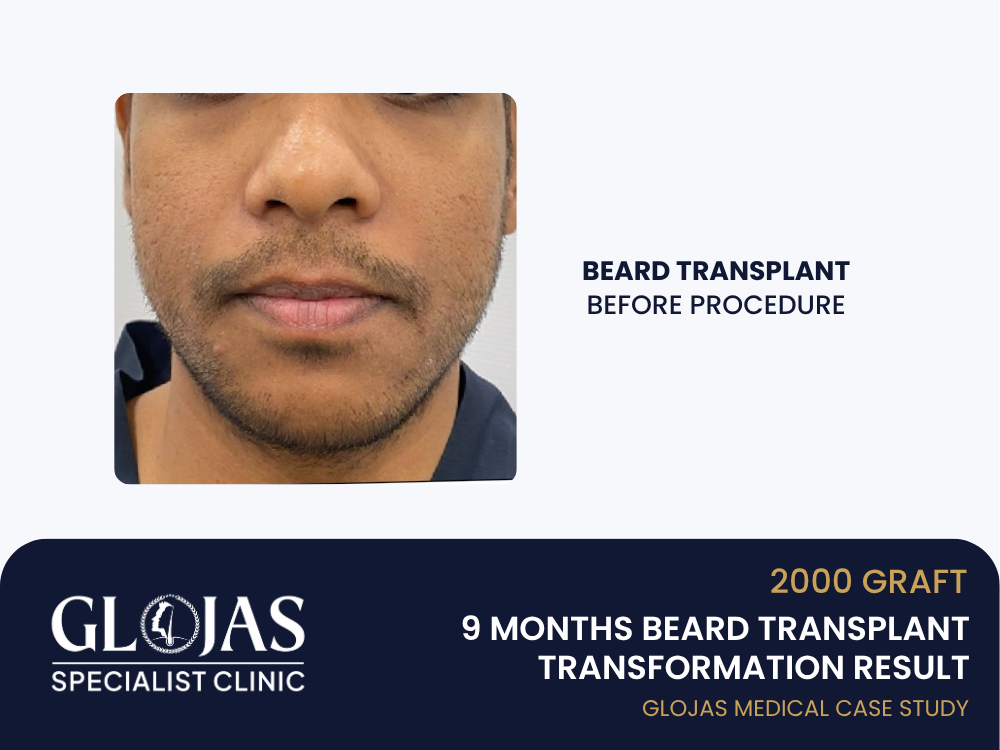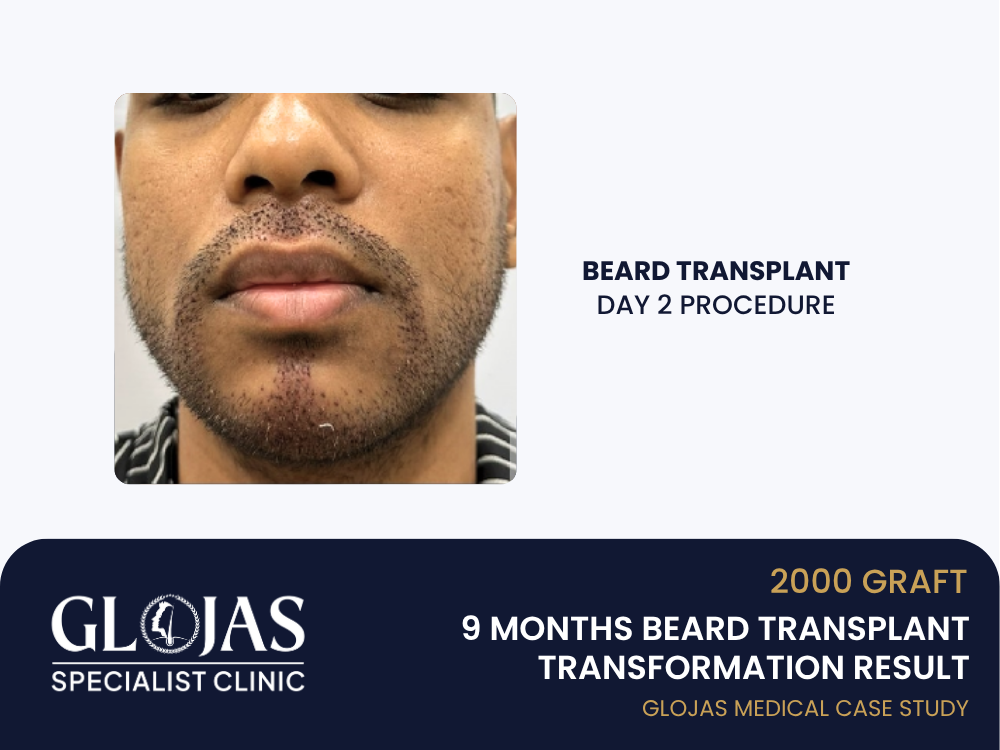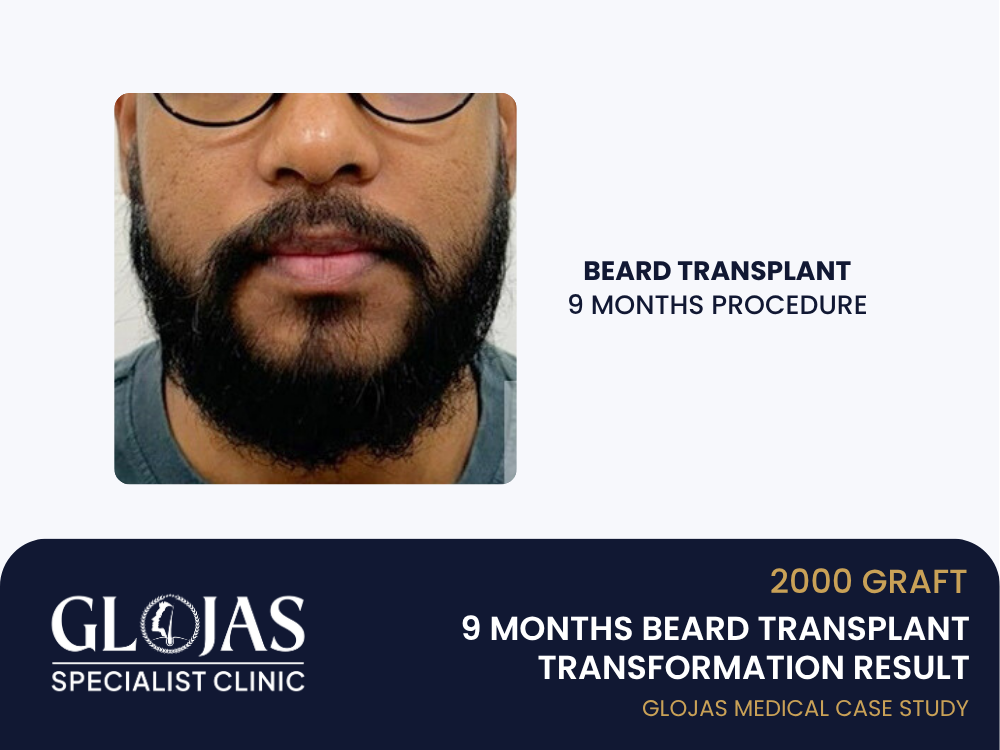In recent years, beards have evolved from a grooming trend into a symbol of masculinity, confidence, and style. However, not all men are genetically blessed with full facial hair. Whether due to genetics, scarring, or hormonal factors, patchy or sparse beards can be too much. This case study features a 29-year-old male who desired a full, well-defined beard and underwent a SMART™ FUE Beard Transplant using 2,000 grafts.
After just 9 months, he achieved a natural-looking, dense, and balanced beard that completely reshaped his facial profile and boosted his confidence.
Patient Profile
Name: Mr. K (identity protected)
Age: 29
Concern: Incomplete facial hair growth, especially on the cheeks and jawline
Beard Density Before: Thin growth on upper lip and chin; cheeks largely patchy
Beard Goal: A full, connected beard with even density across cheeks, jaw, and goatee area
Previous Attempts: Tried minoxidil and supplements — no lasting improvement
Mr. K’s motivation stemmed from personal aesthetics and social confidence. He preferred a naturally thick beard and not being dependent on daily grooming products or temporary fixes.
Why SMART™ FUE for Beard Restoration?
SMART™ FUE (Scalp Micro-Advanced Restoration Technique) is a cutting-edge version of FUE (Follicular Unit Extraction) that’s particularly effective for facial hair restoration. It offers:
Micro-precision in graft placement for realistic facial angles
Minimal scarring (no linear marks)
High survival rate of follicles (up to 95%)
Suitable for both aesthetic design and coverage
Ideal for patients wanting permanent beard enhancement
SMART™ FUE Beard Transplant allows surgeons to recreate facial hairlines with exact depth, direction, and spacing — critical in beard design.
Consultation & Design Planning – Beard Transplant
During the consultation, Mr. K discussed his vision: a full beard with well-connected sideburns, cheek coverage, and a defined jawline.
Key assessments included:
Donor hair quality (from scalp)
Skin type and healing ability
Facial symmetry and natural beard hair angles
Treatment Plan:
2,000 grafts total
1,200 for cheeks (both sides)
400 for the jawline and under the jaw
300 for the mustache and connecting zones
100 for chin and lower goatee
A simulated beard design was created and approved by the patient before the procedure.
Procedure Overview

Date: Single-day outpatient
Duration: 7 hours
Donor Area: Occipital scalp (back of the head)
Tools: 0.7–0.8 mm micro punch, implanter pens
Step-by-step:
Local anesthesia was applied to both the donor and beard zones
2,000 grafts extracted using the SMART™ FUE technique
Grafts sorted by thickness and type (single vs. double follicles)
Recipient sites created on cheeks, jawline, and mustache zones
Grafts implanted following natural beard angles (acute and downward)
There was no significant bleeding or discomfort, and Mr. K resumed light activity the following day.
Recovery Timeline

Days 1–3: Mild redness and swelling on the face
Week 1: Formation of small scabs around implanted hairs
Week 3–4: “Shock loss” — temporary shedding of implanted hair
Months 3–4: New hair began to regrow, slowly filling patches
Month 6: 70% coverage visible, shaping of beard started
Month 9: Full, dense, natural-looking beard achieved
9-Month Results

Mr. K returned for a follow-up appointment at month 9 with impressive results:
| Zone | Before Transplant | After 9 Months |
|---|---|---|
| Cheeks | Sparse to no growth | Dense coverage with natural flow |
| Jawline | Minimal hair | Thick, well-shaped edge line |
| Mustache | Patchy, disconnected from the beard | Strong connection to beard |
| Overall Style | Dependent on grooming to “fake it” | Real, full beard without effort |
Patient Feedback
“Now I don’t need to think twice about shaving or styling. It’s my real beard, and it looks exactly how I imagined. The SMART™ FUE technique was amazing.”
Mr. K also shared that people around him thought he “grew a great beard,” not knowing he had undergone a transplant — a sign of a well-executed, natural result.
Beard Maintenance
Initial trimming after 4–5 months to shape the growing beard
No special care needed after full recovery
Transplanted hair can be shaved, styled, or trimmed just like natural facial hair
Growth continues permanently
5 Frequently Asked Questions (FAQ)
1. Is a beard transplant permanent?
✅ Yes. The transplanted hair follicles are taken from the scalp and are permanent, continuing to grow naturally even after shaving.
2. How many grafts are needed for a full beard?
It depends on the area of the beard and the current density. On average, 2,000–2,500 grafts are sufficient for full coverage in most men.
3. Will the transplanted hair match my facial hair?
Yes. Doctors carefully select donor hairs that are similar in thickness and texture, ensuring the beard looks consistent and natural.
4. When will I see the final results?
Significant results begin at month 6, but full results are visible around 9–12 months, as the hair thickens and settles.
5. Can I shave or style my beard normally?
✅ Absolutely. Once fully healed, the transplanted beard can be shaved, styled, dyed, or trimmed like any natural beard.
Final Thoughts
Mr. K’s 9-month transformation shows the remarkable potential of SMART™ FUE Beard Transplant for men wanting a full, permanent beard. With 2,000 grafts, his patchy and uneven facial hair was turned into a defined, masculine look that fit his face and personal style.
If you’re tired of trying to grow a beard or relying on temporary fillers, this procedure offers a long-lasting, natural solution, designed precisely for your features.
